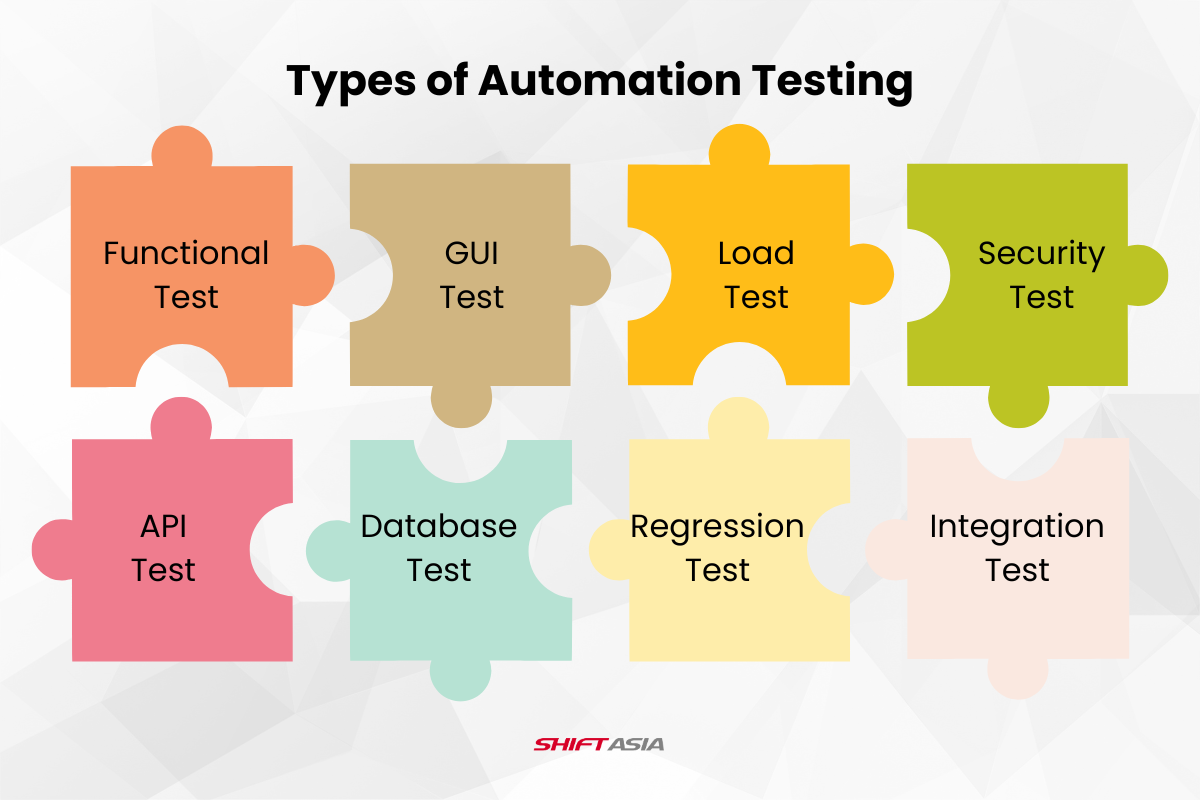Effective eCommerce website testing goes beyond standard web testing techniques. Are you searching for a foolproof eCommerce testing guide containing test planning, cases, and test scenarios to help you test your online merchant site or web store?
Welcome! You’re at the right place!
How many test automation types are there?
Software testing automation is an approach to testing that employs software tools and scripts to execute tests on an application or system automatically. Instead of conducting repetitive manual testing, development, and QA teams leverage test automation to streamline software quality assessment. This involves creating automated test cases and scenarios that simulate user actions and validate whether the software behaves as intended.

There are various test automation methods in software development, each serving a specific purpose and focusing on distinct perspectives of software quality. They have been utilized in software development practice to assess different aspects of an application. Here are a few test automation showdown that are worth mentioning:
Functional Tests include these automation testing approaches:
- Regression Tests: verify whether updates or changes introduce errors in existing functionality, primarily maintaining system stability.
- Functionality Tests: evaluates whether an application meets specified functional requirements by testing its functions and features.
User Interface (UI): focuses on the user’s interaction with the graphical interface, ensuring consistency and functionality across different devices and browsers.
Load and Performance Tests:
- Load Tests: Evaluate how an application performs under maximum load, determining its performance and responsiveness.
- Stress Tests: Assess system behavior under extreme conditions, such as unexpected traffic spikes or limited resources.
Security Testing: Identify security vulnerabilities and weaknesses to protect data and application functionality.
Integration Testing: Analyze the interaction and communication between different components or modules and whether they work together correctly.
API Tests: These tests verify the functionality and communication of application programming interfaces (APIs), which are crucial for applications dependent on web services and APIs.
Visual Regression Testing: compares screenshots before and after changes to detect visual discrepancies and keep the user interface’s visual consistency.
Database Testing: focuses on verifying data integrity and database query functionality to ensure the correct storage and retrieval of information.
With the availability and diversified number of test automation, deciding which test automation types to stick with and how many tests should be carried out for a project can sometimes be challenging. Generally, it depends on the project/application goals, project/application characteristics, and specific quality targeted needs. Many found a combination of test automation types would fulfill the strict and highly comprehensive coverage of software quality. In contrast, others would gladly like to pass on that burden to 3rd party vendors specializing in eCommerce testing solutions for help.
What Preparations Should You Make Before Conducting an eCommerce Test?
The following guidelines will come in handy; make sure you save it for later:
The Business Requirements: Understanding your product goals and requirements is the first and most important step. Have your requirement checklist ready!
Test Environments: Establish separate test environments, akin to a mock store, to conduct testing without impacting the live website.
User Scenarios: Take into account different user types, including new customers, returning customers, and even first-time online shoppers, or you might say “being in their shoes” for once to mindfully test various user journeys efficiently without having any bias as an application developer.
Test Data: Fill your test environment with realistic data, such as sample products and customer profiles, to simulate real-world scenarios and obtain the most accurate test data result possible for further improvements and modifications.
In which functionality should you apply the automated test?
In order to figure out which functionality you would need automation tests on, you must be able to answer the following:
- Functionality that strongly affects the user flow (e.g., payment processing)
- Scenarios that are complicated to apply manual tests or require considerable effort on manual action (e.g., filling numerous forms with particular standards or setting up intricate filter criteria).
- Repeated tests (e.g., when there are various white-label sites with similar code bases but distinct configurations).
If you answer “YES” to all three questions, you need to start researching automation test expertise; it’s one step towards optimal performance, better stability, and faster time-to-market releases.
The challenges of automated testing
Everything comes with a trade-off, and automation testing is not an exception. Automated tests require meticulous step-by-step creation. While a manual tester can interact freely with an application, clicking through each step, a computerized test demands careful instruction.
Like a manual tester who might dismiss a popup window with a click, an automated tester must anticipate and handle the circumstance while writing the test cases. Understanding when the window will appear and how to close it is essential; otherwise, the test process may confront difficulties and eventually be interrupted by obstacles.
Creating these tests can be time-consuming since they are typically developed after a reasonably stable version of the application is available; test automation often finds themselves navigating the ambiguous territory between feature creation and release.
Project managers are eager for quick deliveries post-development, especially when everything seems ready. Unfortunately, this often leaves little time for test automation, contributing to its frequent neglect.
Automated testing in eCommerce
E-Commerce introduces distinctive challenges when it comes to software testing. Digital commerce platforms, including websites and applications, encompass many features, from product catalogs and shopping carts to checkout processes and shipping options.
- Efficiency: Test automation facilitates the rapid execution of a diverse array of test cases, expediting the development and delivery process.
- Consistency: Manual testing is susceptible to human errors and result variability. Automation tests are consistently performed in the same manner, enhancing the reliability and uniformity of evaluations.
- Comprehensive Coverage: Automation empowers the testing of various scenarios involving aspects like site navigation, performance, and security to thoroughly examine all critical functionalities within the eCommerce domain.
Should an eCommerce company choose a QA tool?
An e-commerce company should begin exploring the appropriate QA tool during the development phase of its website. While the ideal time is early in the development process, it’s never too late to start. If you haven’t yet integrated automated software testing into your quality engineering workflow, now is the time to take action. Delaying adoption could lead to increased risks and costs associated with unidentified issues. While you’re at it, explore the various automation tools we have touched base on in our blog “Top 8 Ecommerce Automation Testing Tools”.
Automated testing has become a necessity, not a choice, for e-commerce companies striving to deliver seamless, secure, and exceptional shopping experiences. Suppose you need a hand or guidance in this particular field. In that case, SHIFT ASIA is here to help you take the initial stride toward refining your testing procedures and delivering an unparalleled user experience.
ContactContact
Stay in touch with Us







